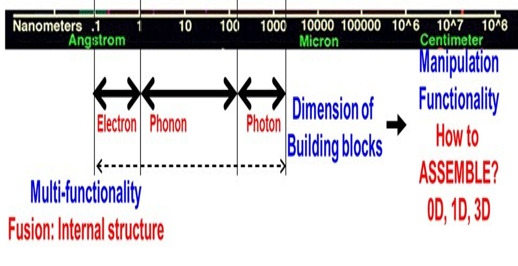Design and Synthesis of
Nano
Energy Materials
Nano
materials with controlled shape, size, structure, and morphology can be
categorized into materials with 0D, 1D, 2D, 3D structures. To apply specific
functionality, the material needs to be designed. For example, new nano
material design is needed in order to control electrons, holes, photon, and
phonons to make the best property possible in photoelectric devices and display
devices. Electron and hole interact at sub nm and phonon interacts with each
other at sub 100 nm. Also, photon, especially visible light and near-infrared
light, interacts at hundred nm ~ ξΉm. Therefore, in order to control
individual property, material needs to be designed in size of interaction. In
addition, to control multiple properties, materials with multi-dimensional
structure with multi-scale needs to be designed.
Also, materialκψs physical, chemical, and
optical properties are different according to its dimension. Therefore to
make materialκψs property more useful, technology to build up materials to make
higher dimension material from lower dimension is needed. For example,
confinement happens the most in 0D materials causing dramatic changes in DOS.
These property makes materialκψs physical and optical performance to rise, but
the ability to transport these special property to other messenger material is
decreased. Therefore, these materials needs to be either transformed or fused
together with higher dimension material. In conclusion, through dimension fused
high-dimensional structure, material can get all the benefits from each
dimensions.

 Material Design and Synthesis
Material Design and Synthesis >Research > Material Design and Synthesis
>Research > Material Design and Synthesis


 Material Design and Synthesis
Material Design and Synthesis >Research > Material Design and Synthesis
>Research > Material Design and Synthesis